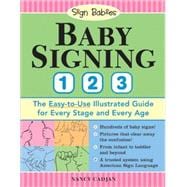
Note: Supplemental materials are not guaranteed with Rental or Used book purchases.
Purchase Benefits
What is included with this book?
| Acknowledgments | p. vii |
| Preface | p. ix |
| A Developmental Look at Signing with Your Child | p. 1 |
| What Is Baby Sign Language? | p. 3 |
| Birth to Three Months-I'm Just Not Ready Yet, But... | p. 29 |
| Four to Seven Months-I'm Ready to Start | p. 45 |
| Eight to Twelve Months-Watch Me Sign | p. 81 |
| Thirteen to Eighteen Months-I'm Ready for More, More, More | p. 119 |
| Nineteen to Twenty-four Months-Look Who's Talking...and Signing | p. 147 |
| Two Years and Beyond-What Can I Do with Signing Now? | p. 169 |
| Signing with Children Who Have Special Needs | p. 185 |
| Baby Sign Language Dictionary | p. 199 |
| Quick Review of Developmental Stages by Age | p. 255 |
| How Signing with Babies Started | p. 261 |
| Resources | p. 263 |
| Index | p. 280 |
| Table of Contents provided by Ingram. All Rights Reserved. |
The New copy of this book will include any supplemental materials advertised. Please check the title of the book to determine if it should include any access cards, study guides, lab manuals, CDs, etc.
The Used, Rental and eBook copies of this book are not guaranteed to include any supplemental materials. Typically, only the book itself is included. This is true even if the title states it includes any access cards, study guides, lab manuals, CDs, etc.